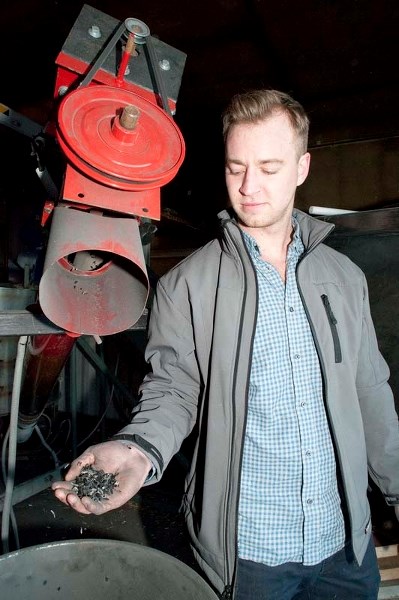A group of St. Albert natives hopes to harness the power of fire to keep more construction waste out of landfills.
Edmonton's Construction Waste Disposal has teamed up with the Northern Alberta Institute of Technology (NAIT) and The Prasino Group to see if it can turn construction and demolition (C&D) waste into char – a substance that can be used to clean water, fertilize soil and trap carbon emissions.
The experiment, which started earlier this month, is being run out of a small red barn on a farm near Millet, about an hour south of St. Albert.
Andy Chapman, co-founder of Construction Waste Disposal and a former St. Albert resident, said his company hauls about two million kilograms of C&D waste a month to landfills around Edmonton.
"We saw a huge issue growing with the amount of volume that was essentially being dumped into landfills," he said.
As about 30 per cent of his company's costs goes to landfill fees, he wanted to find a way to save money by shrinking the amount of junk he takes to the dump.
That's when his employee Chris Olson – a NAIT student and former St. Albert resident – suggested they look into biochar, a type of high-quality char or charcoal that can be used as a soil amendment.
"Right now, something like 70 to 80 per cent of what we end up taking to the landfill is mixed C&D" waste, Olson said.
It's hard to sort and recycle, and many landfills charge more for it.
But it's also mostly wood, drywall and other organic materials – materials that you can transform into biochar.
Olson called fellow NAIT students Chase Bell and Bruce Saunders to see if they could convert mixed C&D waste into biochar. They leased a biochar unit and are now experimenting with it at Saunders' farm near Millet.
Chapman said he's hoping the unit will shrink the volume of material he has to haul to the dump.
"If we can reduce that (volume) by half of what we're putting in right now, we'd see that as being a drastic step in the right direction," he said.
Pyrolysis power
The roughly $300,000 biochar unit consists of a cylindrical furnace plus a rectangular oxidizer, and is capable of producing about 1.5 tonnes of char a day.
"It's essentially a large oven heating the material in an oxygen-free environment," Olson said.
The machine works through pyrolysis rather than combustion, Saunders said.
Combustion oxidizes carbon and releases it as carbon dioxide – a potent greenhouse gas. Pyrolysis heats waste without giving it the oxygen needed to burn, causing the molecules to break apart. This creates an energy-rich gas (which can be burned) and lumps of solid carbon, or char.
To start the process, Saunders piles some waste supplied by Chapman into the furnace and lights it on fire. As the top of the pile burns, it sucks up all the oxygen in the furnace and heats it to about 650 C, triggering pyrolysis in the rest of the pile.
Gas released by this process is burnt off in the oxidizer at about 1,000 C, Saunders said. After about five to 10 minutes, a rotating grate sweeps finished char out of the furnace into a barrel for collection.
The resulting char is super-porous, Saunders said. Add it to soil, and those pores help with aeration, water retention and pollution filtration.
Pyrolysis can also sequester carbon in the ground, removing potential greenhouse gas emissions from circulation, reports the Alberta Biochar Initiative.
Whereas decomposition and combustion return about 99 per cent of the carbon in biomass to the air, pyrolysis traps up to half of it in the form of biochar. Researchers believe it could be an important way to reduce climate change as a result.
Promising results
Initial tests suggests the team can achieve a four-to-one reduction in volume by converting C&D waste to biochar, Chapman said.
"We could see an 80 per cent reduction in the volume," he predicted.
However, the group still needs to do lab tests to see if the char can be safely sold as a soil amendment.
The team plans to do about 30 hours of testing a week with the biochar unit over the next two months, Chapman said.
It's tough for waste companies to get into biochar right now as there are very few commercial biochar units in North America, Olson said. Still, he hopes to show the industry that this technology can reduce mixed waste.
"Landfills are not a long-term solution for holding our waste," he said.
Biochar lets companies cut costs on disposal and potentially make money with a new product, Olson said.
"You make more money if you turn (waste) into something useful instead of just dumping it."




